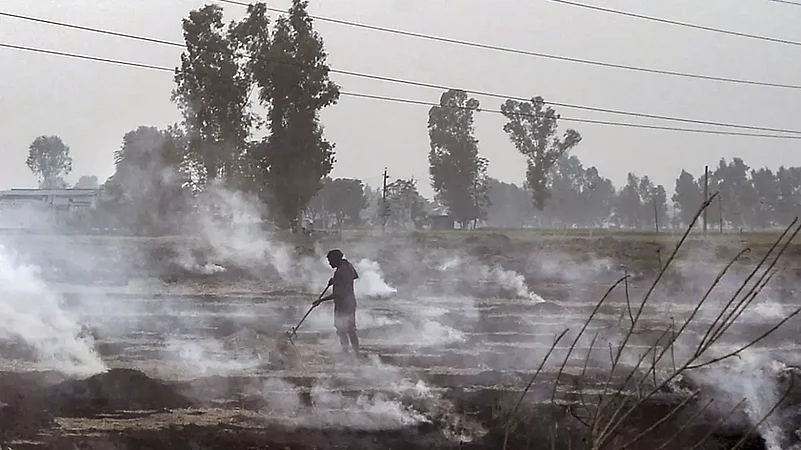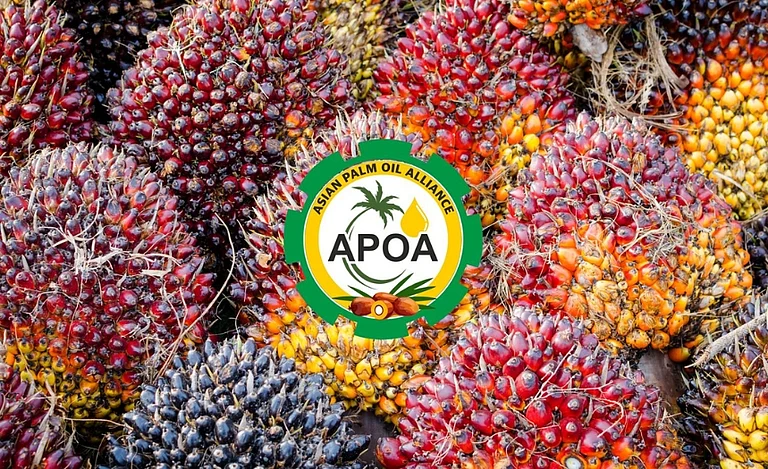Punjab has decided to cut down farm fires by 50 per cent in the coming winter months after being criticised over serious environmental degradations, especially the falling air quality and loss of natural soil fertility due to stubble burning by the farmers.
Environmentalists, who have been proactively trying to educate farmers about the ill effects of burning stubble – the farm residue after harvest – admit that in the past two years, they have seen a notable reduction in fire incidents in the state.
According to the state government data, five Punjab districts — Moga, Firozpur, Sangrur, Bathinda and Muktsar — accounted for around 44 per cent of the total fire counts in Punjab last year, while other districts showed a drop in fire incidents.
Kuldeep Singh, a senior official of the Punjab Pollution Control Board and nodal officer for reducing farm fires, said “A multi-disciplinary committee involving several inline departments, including agriculture and fire services, was handling the matter proactively. All Deputy Commissioners have also been entrusted with responsibilities to reach out to farmers and persuade them to stop stubble burning, rather than adopt alternative measures”.
The Commission for Air Quality Management (CAQM) — a multi-member statutory body set up by the Ministry of Environment, Forest and Climate Change in August 2021, has rolled out its action plan to curb paddy straw burning by 50 per cent.
Nearly 31 lakh hectares of land in Punjab is under paddy cultivation. This, says CAQM officials, will generate around 16 million tonnes of paddy straw (non-basmati) which will be managed through in-situ (mixing crop residue in fields) and ex-situ (using stubble as fuel) methods.
The CAQM said, “ Efforts are being made to use the paddy straw for industrial and energy generation projects. Sizeable quantity of straw will also be used as cattle fodder”
Amritsar-based noted environmentalist P S Bhatti, who has started a drive to engage school students and teachers in spreading awareness about harmful side effects of straw and stubble burning says the campaign is paying excellent results and he has started incentivising the students who help to dissuade their families and neighbours.
“No one had ever told the farmers some of the serious ill effects of the stubble fires. Burning husk on the ground destroys the nutrients in the soil, making it less fertile. The millions of microbes, which are useful to maintain natural fertility and moisture, get killed in the process marking the end of their life cycle. The heat generated by stubble burning penetrates into the soil or also heats up the environment,” he explains.
Bhatti gives credit to the government for reducing stubble-burning incidents by using persuasive means and offering alternatives.
The Punjab Agriculture University, Ludhiana, has also played a key role in suggesting alternatives and also introduced some new models of harvest machines, though the best method to climate the chances of fire is manual harvesting.
A senior official of the Agriculture department at Bathinda said, “We are giving several incentives to the farmers including a facility to sell ‘parali’ (paddy residue) and using Pusa Bio Decomposer. This microbial solution can break down paddy straw in just 15-20 days and will be provided to farmers for free,” he says.
The new action plan envisages the elimination of stubble burning cases this year in six districts — Hoshiarpur, Malerkotla, Pathankot, Rupnagar, SAS Nagar (Mohali) and SBS Nagar — as per advisory issued by the CAQM
In 2021, around 30.28 lakh hectares of land in Punjab was under rice cultivation of which stubble burning was recorded on 15.43 lakh hectares which comes to 50.94% of rice area. Last year, the state burnt residue on 15.64 lakh hectares of 29.69 lakh hectares of rice area which comes to 52.69% of the total rice area.
The state government has involved several NGOs and organisations like the Confederation of Indian Industry (CII) in its drive to advise and support environment-friendly alternatives through interventions focused on creating awareness about the hazards of stubble burning and supporting them in adopting viable alternatives.
Palampur-based Chaudhary Sarwan Kumar (CSK) Himachal Pradesh Agriculture University also suggested a solution to stubble burning two years back — to turn it into cattle fodder.
Stubble burning in Punjab and Haryana is one of the biggest sources of air pollution in Delhi-NCR every year in winter, whose impact can also be seen in the lower hills of Himachal Pradesh, admits its vice-chancellor Dr HK Chaudhary.
The university proposed an innovative and sustainable solution for straw management, which can also help become a source of income for the farmers and the local community. “The straw can be used as a source of income in the cottage industry. We have demonstrated it on the campus and transferred the technology to the farmers looking for ways to handle the straw stock gainfully,” he said.
If the farmers of Punjab, Haryana and other states follow Himachal Pradesh’s cue, they will be able to efficiently utilise it, thereby saving the environment.
“I can see this can be a model for the country,” Chaudhary said.
Himachal Pradesh is always in need of dry and green fodder. Most of the fodder in the form of wheat straw or paddy straw is purchased from Punjab and Haryana. It is stored and fed to animals during a crunch.
Scientific studies have revealed that paddy straw has oxalate and silica anti-nutritional factors which sometimes cannot be fed to cattle. These anti-nutritional factors can be lowered by some physical and chemical methods.
Stubble burning has several harmful effects on the environment. It produces toxic gases that not only make it difficult to breathe for nearby residents but also significantly contribute to global warming. The smoke emitted from the burning of the stubble had also resulted in road accidents.
Stubble fires emit pollutants like carbon monoxide (CO), methane (CH4), carbon dioxide (CO2), aromatic hydrocarbons, and volatile organic compounds (VOCs), resulting in smog. The smog from the subtle fire may not be as harmful as vehicular pollution or factory smoke but certainly a cause of air pollution.
In 2013, when the Aam Aadmi Party-led government came to power in Delhi, it had criticised Punjab and other neighbouring states including Haryana and UP for burning stubble and contributing to the capital’s toxic pollution in the winter.


























